Magnificent Frigatebirds soaring like big black kites overhead are a familiar sight throughout the Caribbean. These birds are also commonly seen harassing and stealing food from other seabirds—a behaviour known as kleptoparasitism—earning them the reputation of being ‘Pirates of the Skies’!
These days, a careful watcher might also see a Magnificent Frigatebird fitted with a small tracking device. These birds are part of an ongoing project, ‘Regional-scale Conservation through Multi-territory Tracking of Frigatebirds,’ for which a workshop was held recently in Anguilla. Following the workshop, one of the attendees, Jennifer Wheeler, caught up with one of the project co-leads, Dr. Rhiannon Austin, in order to talk more about the history of the project and this unique seabird.
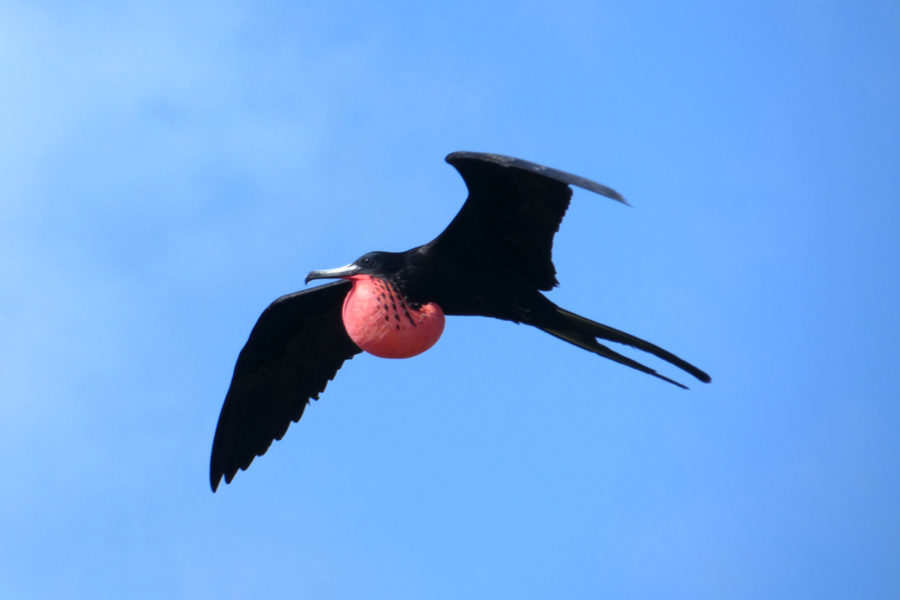
Jennifer, for BirdsCaribbean (BC): Hi Rhiannon. The workshop wrapped up just before COVID-19 shut down international travel. I’m glad you made it back to the UK—first off, how are you doing with coronavirus? I assume it has affected your work schedule?
Rhiannon: Thanks for asking! As in most places, it has changed things notably for us in the UK both professionally and personally, and we are all trying to adapt to the situation. I am currently employed as a Research Associate at the University of Liverpool, which has been shut since just after our workshop in mid-March, and we don’t know when it will reopen yet. Our fieldwork this season has been put on hold for now. However, we are doing our best to keep moving forwards and keep up communications. It is all about supporting each other.
BC: I believe we first crossed paths in mid-2016, when you were developing the proposal for the multi-island Frigatebird Project, but I think you had already started working in the region prior to that. What first brought you to the Caribbean?
Rhiannon: Yes, we corresponded in 2016, but met in person for the first time at BirdsCaribbean’s International Conference in Cuba, in July 2017, which was my first BC meeting. It was such a great experience and a fantastic opportunity to meet and hear from others working in the region. I first started working in the Caribbean in 2011, on a project with the Department of Environment (DoE) in the Cayman Islands that focused on Marine Protected Areas. Although my work on this project wasn’t related to seabirds, I became very interested in the seabird colonies on the islands, and always wanted to write a grant to go back and study them.
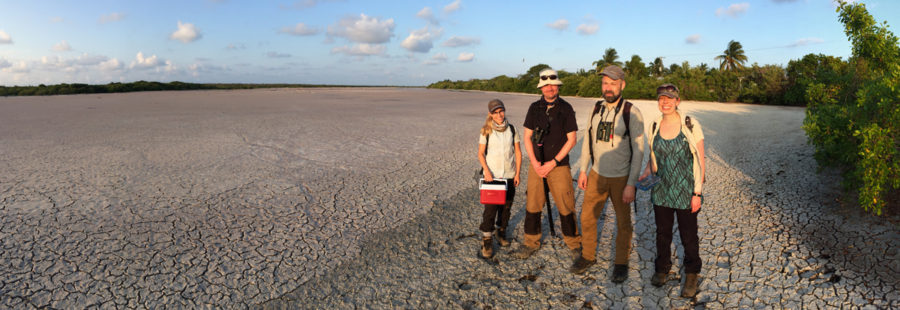
I did this after my PhD in 2015, and our grant was funded! At the time of the BC conference in 2017, I was managing our Darwin Plus project in the Cayman Islands, which started as a two-year collaboration between the DoE, Universities of Liverpool and Exeter, and the National Trust of the Cayman Islands. The project aimed to gain essential information on the at-sea movements, population status, and ecology of breeding seabirds in this UK Overseas Territory (UKOT). I was lucky enough to be able to continue working on the seabird populations here after this funding ended—last year was our fourth field season. The hope is that our collaborative group can continue studying these important populations over the long-term to gain a fuller understanding of inter-annual variability in behaviour and population responses to environmental change.
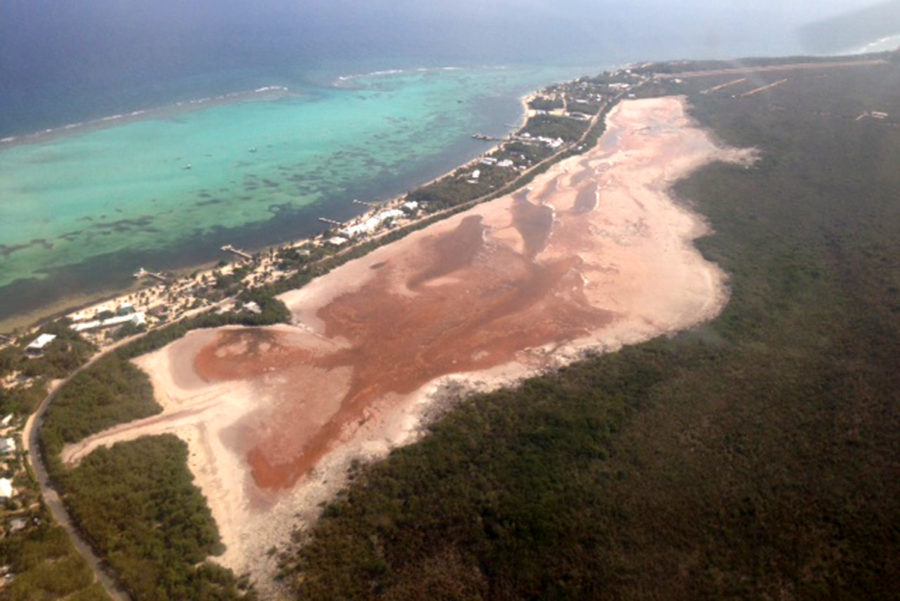
BC: So, your work with Cayman Islands frigatebirds led naturally to thinking about working across several islands?
Rhiannon: Exactly! The DoE and I started working together to tag and track frigatebirds in 2017. We collected some great data that really helped to improve our understanding of the at-sea movements and behaviour of this unique species during the breeding season. These data have also now been used to identify marine Important Bird and Biodiversity Areas (IBAs) during our Darwin Plus projects. We have discovered some interesting things about how Magnificent Frigatebirds from the Cayman Islands exploit their environment, including the tendency of birds to forage both coastally around reefs and sargassum drifts and within the open ocean. We have also detected sex-based differences in their foraging tactics, with males making more offshore trips than females when rearing chicks (you can check out our open access article in MEPS here).
Protecting this species is a real challenge as their large wingspans means that they have low energetic fight costs (i.e. they don’t have to use a lot of energy to beat their wings!), and therefore can forage over huge stretches of ocean. They don’t respect international boundaries and don’t need a passport(!), so it takes cooperative management from multiple nations to protect them across their entire range. The current project that I lead, along with Dr Jon Green at the University of Liverpool, really developed in response to these challenges. Our team wanted to do something to bring those working in the UKOTs together, to discuss ways to extend networks that will help to protect biodiversity. Frigatebirds are really a tool for helping to achieve this aim, as their unique traits make them a potential indicator species for marine biodiversity hotspots. They require better protection, as do multiple species and habitats within the Caribbean.
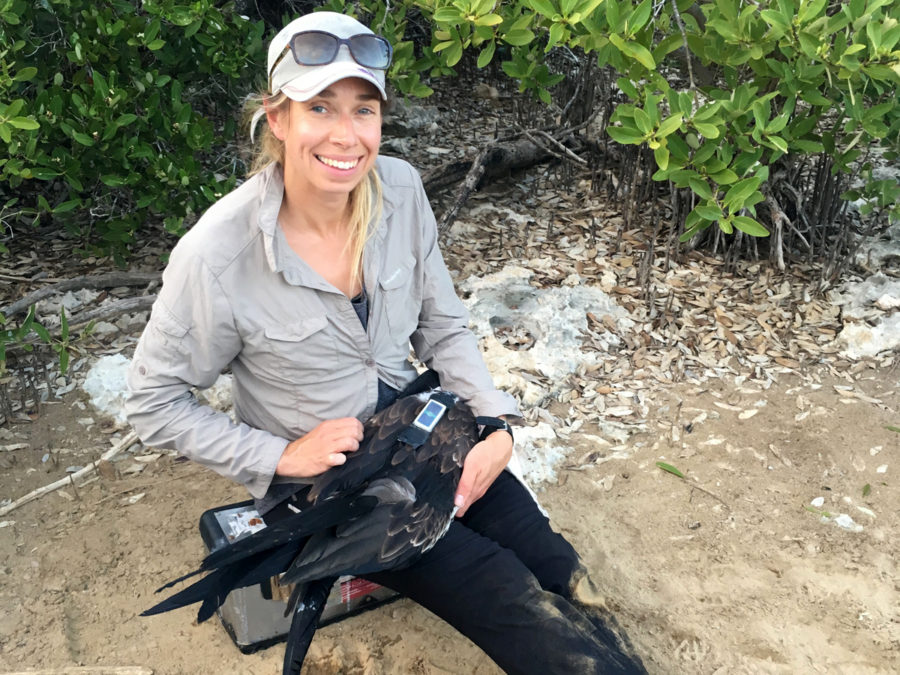
BC: Are all the Caribbean UKOTs involved in the current project?
Rhiannon: Yes, I am lucky enough to be working with partners in all 6 of the Caribbean UKOTs under the current project (Anguilla, British Virgin Islands (BVI), Cayman Islands, Turks and Caicos, Bermuda and Montserrat), as well as BirdsCaribbean who it is great to be partnering with. The recent workshop on Anguilla was attended by partners from all of these territories including the Anguilla National Trust (Anguilla), Department of Environment – Cayman Islands Government (Cayman Islands), Jost van Dykes Preservation Society (BVI), Department of Environment and Coastal Resources – Government of the Turks and Caicos Islands (Turks and Caicos), Department of Environment – Government of Montserrat (Montserrat), Department of Environment and Natural Resources – Government of Bermuda (Bermuda), and BirdsCaribbean (see photo). It was great to bring everyone together to discuss the work that we are doing, and how it might help with the large task of addressing conservation issues within marine and coastal environments in the UKOTs.
I’m currently combining and analysing data from multiple Caribbean frigatebird populations to investigate what habitats this species uses at sea and on land (where they like to roost and feed), and to predict suitable habitat across the region (including within areas that we have no data for). The hope is to use frigatebird tracking data in habitat modeling approaches to identify areas of ecological importance relevant to not only frigatebirds but other mobile marine vertebrates. There is another year and a half left on this project and it will end with a large workshop that our project team plans to host during the next BirdsCaribbean Conference in 2021. We hope to open this up to those working in non-UK states and territories in the Caribbean that are interested in seabirds and related conservation issues.
BC: Have you found partners outside of the UKOTs?
Rhiannon: Yes, I’ve recently started a collaborative project with NGOs and Government departments in the Yucatan Peninsula in Mexico. They have large and important populations of seabirds in this area but desperately lack funds for monitoring and conservation. We were due to start preliminary work on this project during the spring/summer, but this had to be delayed for now because of recent events. However, we are committed to seeing this happen once borders open up again and it is safe to proceed. Through the Frigatebird Project, we have also recently started collaborating with some fantastic conservation and research organisations in the States (the Avian Research and Conservation Institute – ARCI) and Canada (University of New Brunswick / NSERC), who have worked on frigatebird populations in the Florida Keys and Barbuda, respectively. I am also always keen to make new connections with those interested in the spatial ecology and conservation of seabirds and other marine vertebrates in the region.
BC: Where are you finding funds for this work?
Rhiannon: This work is largely funded by the UK Government’s Darwin Plus grant scheme, which aims to fund local projects to help protect biodiversity and the natural environment in the UKOTs. The team and I at the University of Liverpool have been lucky enough to have undertaken a number of projects in the UKOTs supported by Darwin Plus, and I really hope that our collaborative group will continue to have success working under this scheme, as our conservation and research activities continue in the Caribbean. My work in Mexico is currently funded by an ‘Early Career Researcher’ grant provided by the University of Liverpool, but we hope to seek funds for longer-term work in the future.
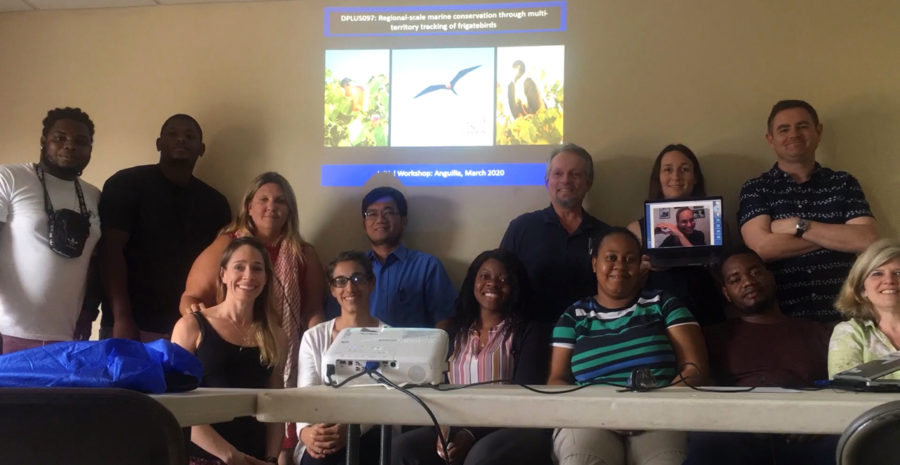
BC: Where would you like to see the project go in the future?
Rhiannon: We really hope that this project, and the outputs that it provides, will help to build new collaborations and working relationships amongst those in the UKOTs (and more widely) that have shared issues and/or knowledge that can be exchanged. The ultimate long-term goal is that this will lead to the development of transboundary management strategies. This a huge task and not an easy one that can be addressed in this project, as it requires involvement of so many nations and organisations. Here, we are starting by identifying training, data and management needs in the 6 UKOTS, and will then undertake supporting activities in these territories (for example, colony surveys or feasibility studies) that will hopefully lead to future funding and longer-term project work. Our final workshop in 2021 will focus on ‘Connectivity and Networks’, and it will be a great opportunity to make steps towards these objectives.
BC: Frigatebirds connect the Caribbean – and beyond. What else makes frigatebirds special?
Rhiannon: Frigatebirds are unique. If I could spend the rest of my lifetime studying them, I would be happy! They are very different from many other seabirds, both in terms of their at-sea behaviour and breeding strategies. Associated with this, they have evolved some intriguing morphological (body) characteristics. For example, they lack waterproofing on their feathers so are constrained to forage at the ocean’s surface. Because they don’t dive under the water, they also lack webbing on their feet, which are adapted for roosting in mangrove trees where they nest. Frigatebirds also have impressive wingspans which allow them to roam huge distances with ease, even when rearing chicks! They also have a very interesting breeding strategy. Females have much greater roles in parental care than males: while the male deserts the chick after only a few months, females may continue rearing chicks for over a year.
Frigatebirds get a lot of bad press because they regularly steal food from other birds. Did you know that the name ‘frigatebird’ and associated nickname ‘Man O’War bird’ refers to the warships favoured and feared by pirates between the 16th and 19th centuries? Personally, I think that this foraging tactic is fascinating and actually quite smart in an environment where prey distributions may not be predictable in time or space! Despite my obvious biases towards frigatebirds, we have a diversity of seabirds in the Caribbean (>20 species) that use a range of life history strategies to successfully exploit and breed in this environment. There is so much to learn. In addition to frigatebirds, I spend time working on boobies, gannets, and shearwaters, but the former remain my favourites!
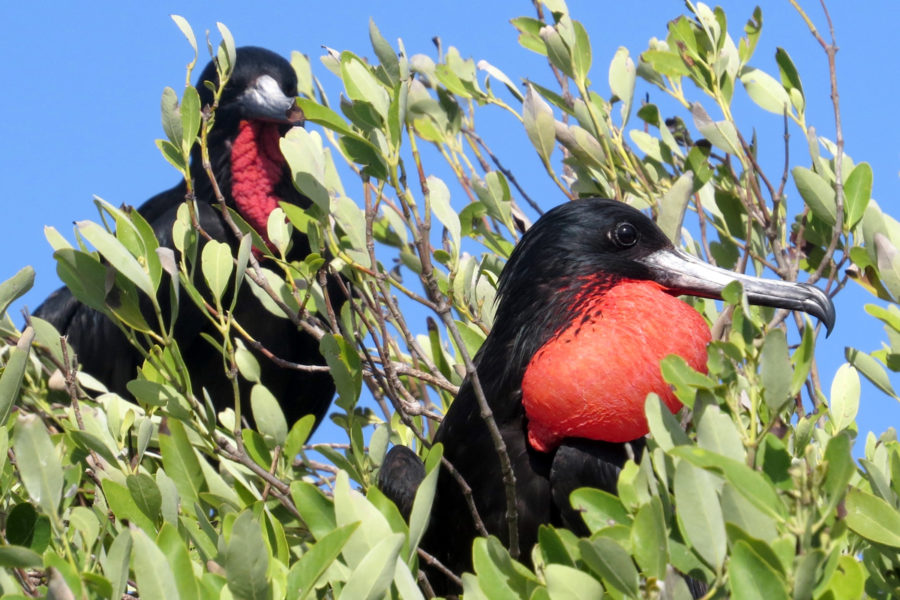
BC: You have worked in other parts of the world, including the Mediterranean… how would you compare the two regions?
Rhiannon: I have always gravitated towards warmer climates, and I feel a strong affinity with the Caribbean. It is where I hope to be based in the long-term. I worked in the Mediterranean on shearwaters for 4 years, and the two regions do have some similarities. Both have high levels of biological connectivity between the many coastal habitats that they contain, and both experience high levels of human activity and associated pressures on their marine and coastal ecosystems.
As with the Caribbean, the Mediterranean has many conservation issues to overcome. However, there are a number of initiatives in the Mediterranean that we might be able to learn from to help with the particular challenges faced in the Caribbean. For example, recent efforts to undertake observer programmes onboard fishing vessels are helping to address bycatch of seabirds. Similarly, there are initiatives to identify and designate interconnected networks of MPAs. Spain’s efforts at site protection are a good example of this. Nevertheless, these types of conservation action only work if multiple stakeholders and nations work together in their efforts, which we all know is challenging. One of the reasons that I enjoy working in the Caribbean so much is its people, and the diversity of birds in the region, many of which we still know so little about. There is so much here to discover and protect!
BC: Do you have a favourite memory from the project that you would like to share?
Rhiannon: There are so many to choose from! Some funny and some just magical! I’ll give you one of both. I think one of my favourite ‘amusing’ memories was watching one of my research assistants (who hates fish) being regurgitated on by a frigatebird while in a very precarious position during work at the colony, which he could not move out of for about 10 minutes. He had to grin and bear being covered in half-digested fish while the rest of us tried desperately not to laugh as we worked!
Withholding regurgitates, the Booby Pond Nature Reserve on Little Cayman is one of my favourite places on earth! Working there over such extended periods of the year means that I am lucky enough to get to see sights and behaviour that few in this world observe. These include adults feeding their chicks, scuffles between nest neighbours, juveniles playing with nesting material in the sky, and fledglings finding their wings and taking off the first time! It is a privilege and an honour to work with such amazing creatures. The noise of the colony alone is something to behold! Imagining these sights and sounds is definitely a great way to find peace and calm while in lockdown in the UK (check them out in this video clip!).
